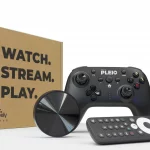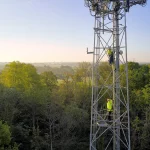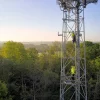First Ultrafast 8Gbps Capable 802.11ad 60GHz WiFi Kit Gets Certified
After several years’ of development the Wi-Fi Alliance has this week begun to certify the first hardware (routers etc.) to use its final WiGig 802.11ad (60GHz) standard, which can push data rates of up to 8Gbps over a WiFi wireless network. But you need to be within 10 metres for it to work properly.
The IEEE officially approved the new 802.11ad standard all the way back in 2013 (here), although it took a long time to build the hardware and the first unofficial broadband routers to support it (e.g. TP-Link Talon AD7200) didn’t even begin to surface until earlier this year (here).
Advertisement
Using the 60GHz radio spectrum band certainly affords plenty of potential for fast data rates, but the caveat is that transmissions at such high frequencies tend to suffer from very limited range (up to 10 metres for its top speeds) and struggle to penetrate through any even remotely solid surfaces.
Admittedly some of the limits can be overcome by using millimeterWave (mmW) circuit design and wide-coverage beam-forming antennas, but there’s no escaping the fact that high frequency spectrum just isn’t designed for delivering good coverage (short of installing signal boosters in every room).
On the other hand there’s less congestion at 60GHz and WiGig isn’t intended to deliver whole-home coverage, instead it’s focused more on offering a low latency and high-throughput line-of-sight solution for cordless devices that need to move a lot of data (e.g. future VR headsets). We’re still not convinced about the use cases for WiGig, but the expectation is that it will eventually be widely supported.
Phil Solis, Research Director for ABI Research, said:
“Wi-Fi Alliance certification has a strong history of accelerating broad technology adoption across the industry, and we expect 2017 to be a breakout year for WiGig on the heels of Wi-Fi CERTIFIED program availability.
The ecosystem for WiGig spans the mobile, PC, and consumer electronics industries across the consumer, enterprise, and service provider markets. Devices will leverage the brand and ubiquity of Wi-Fi for continued momentum across these industries.”
The first Wi-Fi CERTIFIED WiGig products come from Dell (Latitude™ E7450/70), Intel (Tri-Band Wireless), Peraso (60GHz USB Adapter Reference Design Kit), Qualcomm Technologies (client and router solution based on the QCA9500 chipset) and Socionext (Reference Adapter).
Advertisement
No doubt many more devices will follow, although as usual it’s often best to avoid the first generation of new kit and wait until it has had a chance to mature. Not to mention the fact that right now you can’t actually do anything useful with WiGig unless you have at least two supporting devices that sit in a line-of-sight.
Mark is a professional technology writer, IT consultant and computer engineer from Dorset (England), he also founded ISPreview in 1999 and enjoys analysing the latest telecoms and broadband developments. Find me on X (Twitter), Mastodon, Facebook, BlueSky, Threads.net and Linkedin.
« Study – Mobile Broadband Still More Popular than Risky Public Wi-Fi
















































Comments are closed